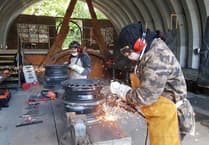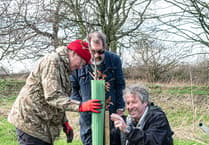One contribution to our letters column this week suggests watching the starling murmuration at the Somerset Levels during the colder months
“
We may think our winters are cold and horrible, but to birds coming from North America, - who fly to the UK in their millions - compared with their summer quarters, our winters are positively balmy. Many come to Somerset and one of our now famous reserves.
Hundreds of people visit Ham Wall every night from October to early March to see the famous starling murmuration (phone the Starling Line for the latest info) but there are other reserves.
Not everyone has binoculars or a telescope, so why not make a winter visit to RSPB Greylake, situated on the A361 a few miles south of Ashcott (parking and entry free). The paths to and from the car park to the hides (a few hundred metres) are good and suitable for mobility scooters and wheelchairs, other paths are not.
Having parked look for various tits, buntings, sparrows, starlings, redwings, fieldfares, woodpeckers and others. Then start your walk to the hides between reedbeds, always listening and watching because almost anything can turn up. If the wind is blowing across the path then briefly duck down and you will be surprised how much protection the reeds offer, one of the reasons so may birds roost in them.
As you walk between the reeds, listen out for many exciting sounds - two potentially scary. The first is the blood curdling sound of a piglet having its throat cut, but don’t worry it is a water rail. Another, heard in the New Year, is the boom of a bittern. The deepest bird call in the world, it is so loud it can be heard two kilometres away. Normally fairly distant at Greylake, it may come from a bird hidden in the reeds just a few feet away, if not expected it is enough to make one jump out of one’s boots. Another loud noise is the ‘Cetti, Cetti, Cetti’ of the Cetti Warbler. It is amazing how such a small bird can make so loud a noise.
Nearing the hides the piping of the teal and whistling of widgeon start to be heard and in spring the ‘tonk tonk’ of the shoveler. If several birds are tonking together it sounds like a demented diesel engine. From the hides in winter you’ll normally see hundreds, possibly thousands, of birds such as teal, mallard, shoveler, pintail, tufted duck, swans, geese, lapwing, golden plover, great and little egrets and waders like snipe. Snipe are ground-coloured with stripes the colour of reeds or dead grass, when they freeze they can be invisible to the untrained eye even when just a few feet away.
Another exciting sound is the bugling of cranes, big birds that have an eight foot wing span and which were our tallest bird until the great white egrets started to nest in Somerset (and yes you may see them too).
If, in winter, one arrives at the hides to find hardly any birds, then you have just missed a hunting peregrine or harrier. The ducks and waders have an aversion to being eaten (don’t we all) so move away, just wait a while and they will come back.
Dress up warm and you’ll have a few lovely hours and a much lower blood pressure, stress level and heart rate and you’ll sleep better as a result, better than pills.
Enjoy wildlife and the great outdoors, then look up the RSPB’s Bath and District Group to meet many of the top writers and producers of TV programmes at their monthly talks or join one of the regular field trips. The Group welcomes people of all abilities. And especially beginners.
John Yates



